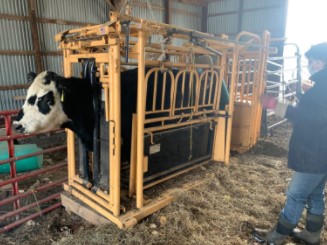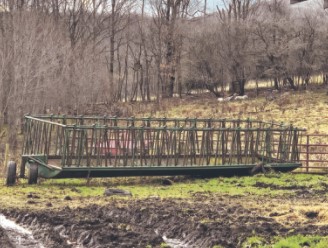By Rich Taber
This is the third installment in a multi-part series on raising beef cattle on the small farm. Previous installments can be viewed in the Summer and Fall editions of Cornell Small Farms Quarterly. This article will bring to your attention some equipment considerations that you must take in efficiently feeding your beef cattle and safely handling them.
The first thing to be considered is feeding equipment. What with our long winters in the Northeast, we typically end up feeding stored dry hay or baleage for about six months of the year. Many beef producers end up feeding these hay crops in large square or round bale form; some folks still feed small square bales too. All forms of livestock will waste a certain percentage of feed. We attempt to minimize this from happening with the judicious choice of mangers and feeders. We want to achieve maximum benefit to the animals and ensure their safety as well as for humans too.
If you were to just go out into the barnyard and dump hay without using feeders, in a short time a huge percentage of the feed would be wasted. We also want feeders that can be moved readily with a tractor front end loader, so that we don’t create a quagmire of mud and manure in the barnyard from feeding in the same location day after day. You might ask, but what about bale grazing? Bale grazing is a viable feeding method whereby bales are placed way out in pastures with the string, or netwrap, and plastic removed from them. The cows feed on them, and much of the waste is returned to the soil as fertilizer and manure. This is a viable technique, indeed, but not for the barnyard. Some people also have good success with rolling out their bales, either by hand or with a special device that unwinds the bales onto the ground. This is also a viable technique in the right place and time.
But back to the barnyard, where we are trying to prevent mud and manure buildup and are not concerned with bale grazing or unrolling. Much, if not all waste can be prevented by putting bales in rugged, well-built feeders. Cattle are anything but delicate creatures, hence the oft-quoted “bull in a china shop” description. Many producers use the “ring” type feeders available from many vendors, especially the “big box” farm supply stores. These are OK for a while but before too long they typically get smashed into scrap metal by the animals and from moving them with the tractor front end loader spear. They typically cost about $300, but they do not last too many years.
I have had much more success with simple, heavy-duty rectangular feeders, on their own skids that I get from a local vendor. They are designed to hold one to four bales and start out in price at about $1000 and up, depending on size. There are also feeders built with extra design features to cradle the bales in the feeder to further prevent waste, but at a higher price. I like the kind without wheels on them, as I can gently flip them over when I want to clean them out, by using a round bale on the front end loader and gently flipping them over, emptying the spoiled hay out, and rolling them one more time back upright. Of course, to feed heavy round or big square bales you have to have a reasonably good-sized tractor with a front end loader and preferably with four wheel drive. With all of the mud, muck, mire, snow, slop, frozen ruts, etc. that we accumulate in our northeastern winters you will soon discover the folly of trying to ram around through all of these evil conditions with just a two–wheel drive tractor with a heavy bale on a front end loader!

A squeeze chute that allows the safe and efficient handling of animals.
Sooner or later, we will need to handle our cattle for a variety of management activities, such as pregnancy checks, vaccinations, dehorning, castrations, worming, ear tagging to name a few. As mentioned, beef cattle are big, rugged, and in confined quarters can be exceptionally dangerous when not controlled properly. You will also have difficulty in procuring the services of a veterinarian if they have to risk life and limb every time they come to your place and you have little or no handling equipment. Well, you have heard the old saying, “buy once, and cry once.” You will have to resign yourself to sooner or later buying a decent, well-built squeeze chute, and with an appropriate set of gates, chutes, and a handling corral. The “bud box” is a very popular type of handling system and plans abound on the internet to see one in action. Temple Grandin is a very well noted authority on the humane and safe handling of livestock, and she has produced several books on this topic available from a variety of sources. She provides much information for you to ponder in handling your animals.

A headlock feeder that the author no longer uses due to animal injuries.
I have used a hay feeder wagon with its own headlocks to capture cows but have since abandoned the practice. I have had a couple smaller animals die in this contraption, and almost lost a mature bull a couple years ago when he got his head jammed into a corner of the wagon. Climb into a feeder with 20 enraged and unruly cows locked in their headlocks and you will feel like you’re on a Great Lakes ore carrier during a ferocious winter storm. Then try injecting a cow with a hypodermic needle when you’re hanging on for dear life as you are tossed around inside the wagon!
I also discovered that there is always one animal, you know the kind, the smart, diabolical kind that will refuse to stick their head into a headlock, regardless of how many goodies and treats you try to entice them with. Guess what? You’re not going to be able to perform the needed management activities on that animal. Some herd bulls are particularly notorious for not being able to be captured in these devices. I know that I have only touched upon some highlights on feeding and handling equipment, but hopefully have given you enough information to begin thinking about how to set up your beef cattle infrastructure. Remember, safety and efficiency are of utmost importance!
Source : cornell.edu